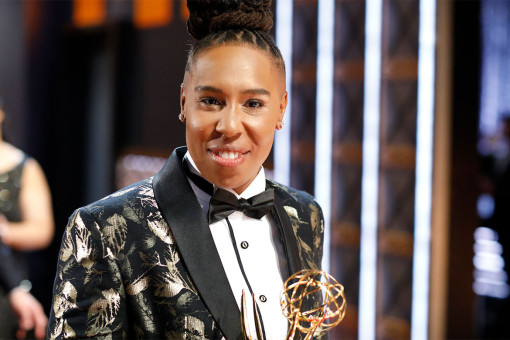Whether he's writing, producing or creating art, Phil Savenick is above all things, a storyteller.
He is an expert at archiving entertainment history and then compiling the best moments of TV and film into a window in which the world can peer. He has three Emmy nominations to prove it.
Self described as an artist, filmmaker, writer and nut, he keeps a healthy sense of humor about his adoration for television. But his utmost respect for the medium, and entertainment in general, cannot be denied. His house is adorned with not only his own art honoring TV, but also cherished relics including Mary Tyler Moore's hat, Bob Hope's golf ball and vintage televisions from every single decade since it was invented.
So then, who better to honor and preserve the estate of the inventor of the first electronic television, Philo Farnsworth? (Savenick's house also contains a healthy shrine to Farnsworth, including his scientific journals and original inventions, which have been sent to him from Farnsworth’s family.) 2017 marks the 90th year since Farnsworth’s image dissector tube transmitted its very first electronic image and the world hasn't been the same since.
But as much as this is a story about Farnsworth, Savenick is just as important. Because while Farnsworth literally manipulated electrons into visible light, Savenick is shedding this light in a historical sense and helping people see the genius behind this tragically underappreciated inventor and visionary.
What's your background?
I grew up watching television. And I love television. All of my best childhood friends, all of my most important childhood teachers, were all of these people on television. I spent about 35 years as a television writer, producer, director and editor.
I realized that we all had common memories and common frames of reference. We sort of became what we beheld on TV. Now I'm not saying we all got to be Indian chiefs or cowboys or astronauts, but we were inspired by the things we saw. There were things we saw on television we couldn't experience in a million years.
You've written and produced many great TV compilations. Tell us about that.
At 20, I began doing a lot of programs on the history of the movies, movie studios, TV networks and on the history of television itself. And everybody started to realize, I watch television better than anyone else.
In 1989, I was one of the producers of the Emmys, and I said depending on how you count it, this could be the 50th anniversary of television if you assume it was introduced at the 1939 World's Fair.
What do you think it is about TV that's so special?
I began to fall in love with the boxes. It turns out that if I wanted to collect Rembrandt paintings, I couldn't afford any. But if I wanted to collect black and white television sets, I could be the king of the world. They had no value, as we are not a society that reveres old electronics. So I began to collect early televisions.
Certainly, the things that happened on television made you feel that anything was possible. And what I found out later - the idea that anything is possible - is where television came from to begin with.
Is this where Philo Farnsworth comes in?
Television was invented by a teenager. He lived on a farm with no electricity. There was no air travel. He hadn't once used a telephone. But what he had were science fiction magazines that inspired his imagination.
There was an old Delco generator that he managed to clean and fix and it was generating electrons. And this teenager became fascinated by electrons. His job was to plow a field all day, dawn to dusk, riding behind these horses, making lines in the dirt.
One day, from this combination of electrons, science fiction and the lines in the dirt, he started to see pictures in the lines. He decided at 14, if he could train an electron to do what his horse did, go to the end of the row and turn back, then he could send pictures through the air.
The next year he started high school. Philo drew the picture of the first television camera. He said it will be like a jar and will have this regular lens that will focus on an optical plate. He'd create a vacuum with electromagnets and a scanner that will scan the pictures one at a time. And he would draw the picture one at a time, convert it into an electronic image and then send it out as a trail of electrons. When it reached the receiver, it would be reassembled one line at a time to make the picture.
The teacher saved this drawing of the first television camera.
How did you get so involved in telling his story?
In 1989, because we were celebrating the 50th year as though television began in 1939, I started to realize that was kind of sham. Because RCA publicity had said they'd invented television. And they sent their press releases to Encyclopedia Britannica and all of the news sources.
There wasn't a patent?
Well, it didn't matter to the public who had the patent. What mattered was what they read in the newspapers and magazines. So basically when Encyclopedia Britannica releases a press release from RCA, you're forgotten to history.
How did you help bring this to light?
In 2004, I think, they were celebrating the 75th anniversary of television at the Emmys. Gary Smith was the producer. I told him, "Television was invented by Philo Farnsworth. His wife, Elma, is still alive. She's 92. Why don't you at least invite her if you're gonna pay tribute?" And they did.
And I stalked and found her in the ladies room. To every single person who came out of the ladies room, I said did "You know this is the mother of television?" Her husband invented it, he's the father obviously. But when he pointed a television camera at a human for the first time, who do you think he pointed it at?
It was her?
It was her! The first person ever televised.I introduced her to people I didn't know. I said to Glenn Close, did you know this is the mother of television? She got down on one knee and kissed Mrs. Farnsworth's hand. She said "Without you, I don't think I would have had a career."
Back to that patent. What happened?
RCA had bought the patents for all the parts of the radio. So the goal was to also own all of television.
But this kid has a patent from 1927. And he's got a book and he's got the tube. They offered Philo a million dollars, which was during the Depression. He said no, I'm gonna get a royalty on every single television ever made. I'm not selling it and I won't go work for you.
RCA sends this scientist named Vladimir Zworykin, who is credited as the inventor of television, to Farnsworth's lab in San Francisco. He just shows up at the door. And he tells one little lie. He says, "I'm from Westinghouse Laboratories and we might want to license your product. How does it work?"
And he told him?
Farnsworth shows him. He builds the tube and the receiver. He's with him three days. Zworykin goes back to his hotel and writes a 700 word telegram stealing the idea. The Farnsworth lab has been rebuilt in New Jersey by the time the train is there. And they spend the rest of that decade trying to work around the patents. And they find out they can’t.
So then they take him to court to contest the patents. Court case goes on for three years, but then the teacher shows up with the drawings. And the judge knows that Philo Farnsworth invented television and he's awarded the priority of invention. RCA had never paid a royalty and have to pay him back. They promise him a million in 1935, but only pay him one year.
His dream had been that TV would bring world peace. That we'd all see each other and know we were the same person. Then Farnsworth realizes that the first to patent, is the first to expire. So he realizes he's not going to be a part of the development of television and he's not gonna get a royalty on every set. They can use his technology after 17 years.
In 1957, Philo was on I've Got a Secret and it was heartbreaking that people didn't know who he was. But did they at least acknowledge that he was the true inventor of TV?
No! That's why nobody knew him. The encyclopedia still said Vladimir Zworykin invented television.
Rightfully so, he has a nervous breakdown, as he realizes his life's work has been stolen. He goes to Maine to the forest. And we detonate the H-Bomb. He's very involved with subatomic particles and electrons…
Had he met Einstein?
They talked on the phone. And it was significant because Farnsworth's last project was called "nucleonics" - the combination of nuclear energy and electronics. He was ready to give up because this invention was also stolen. But Einstein said, "You must not give up. Your work is too important."
What did he do in the meantime?
Farnsworth invents another 50 things for the military. Infrared for the scopes on the snipers, so they can see at night. His cathode ray tube is instrumental to radar.
Then, In 1969, he gets a package in the mail from NASA of a television set and they ask if he'll inspect it. And he does. No one knows about this because it's top secret.
July 20, 1969, he says to his wife "Okay, turn the damn thing on." And the first image they see are live televised pictures from the moon! Now at that moment, his wife says, "So was it all worth it?" And he says, "I think so. But up until this minute, I wasn't too sure."
So back in 1935, when he did his first demonstration of television, he told the cameraman to go up to the roof and shoot the moon. So he becomes the first person to photograph the moon from the earth. And then it's his camera photographing the earth from the moon.
What would you like television enthusiasts to take away from all of this?
It defies reason that Dr. Farnsworth's first notes and experimental tubes should be in my house. And it defines my destiny that they are.
The important thing to me about this story - if this story comes down to one sentence, is: the story of a teenager who had a big idea, was able to manifest it and change the world. To me, that's very inspiring and touching. My part of this story is to somehow get it to some other teenager, who is then somehow inspired to think, my crazy idea might not be so crazy.
Now that your message is reaching more people, what will become of all of these relics?
Some of it going to go to the MZTV Museum of Television in Toronto. Some of it may go to the Museum of Broadcast Communication in Chicago. I'd love to spread it around and keep some of it in Los Angeles. So perhaps George Lucas, when he builds his museum, might find a place. His museum is about storytelling and here's a great story about a 14 year old who really revolutionized television.
So I'm hoping in all these different places, there will be little tributes to this kid who had the big idea.
Savenick recently joined Farnsworth’s fans and remaining son and grandchildren at the site of his San Francisco laboratory to celebrate the 90th year since Farnsworth first demonstrated television.
Much more can be found out about Philo Farnsworth here.
















